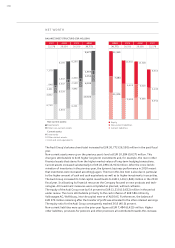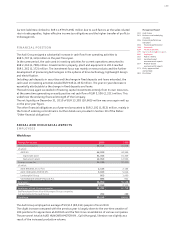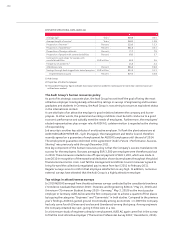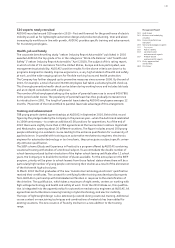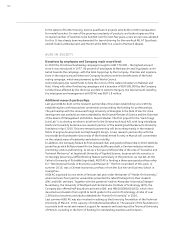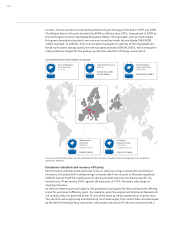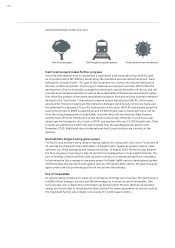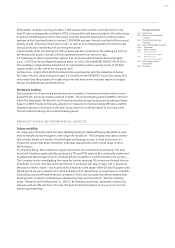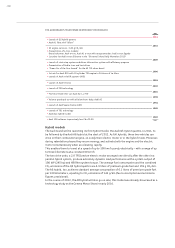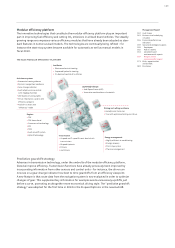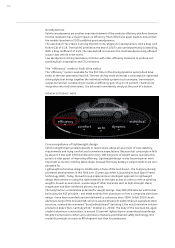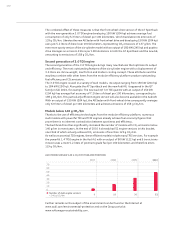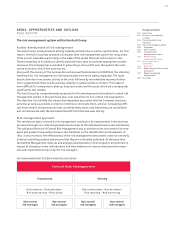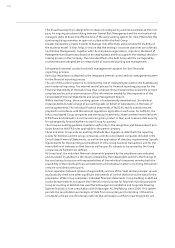Audi 2010 Annual Report Download - page 169
Download and view the complete annual report
Please find page 169 of the 2010 Audi annual report below. You can navigate through the pages in the report by either clicking on the pages listed below, or by using the keyword search tool below to find specific information within the annual report.
167
Management Report
132 Audi Group
141 Business and underlying
situation
156 Financial performance
indicators
159 Social and ecological aspects
159 Employees
162 Audi in society
163 Location-based
environmental aspects
167 Product-based
environmental aspects
173 Risks, opportunities
and outlook
183 Disclaimer
Photovoltaic modules covering a further 7,500 square meters of the new body shop for the
Audi A3 were subsequently installed in 2010, bringing the total area set aside for this technology
to around 19,000 square meters. The newer modules bring the total yield of all photovoltaic
systems at the Ingolstadt plant to around 1,500 MWh per year. Around one-third of this is used
directly in situ, reducing transmission losses. As well as new charging stations for electric cars,
various production machinery will use this green power.
A photovoltaic plant comprising 10,700 modules was also installed on the parking lot roofs at
the Neckarsulm plant in October 2010 to generate power from the sun’s rays.
A 17,000 square meter photovoltaic system was commissioned at Automobili Lamborghini
S.p.A. in 2010 at its Sant’Agata Bolognese plant. In 2010, VOLKSWAGEN GROUP ITALIA S.P.A.,
Verona (Italy), completed the installation of a photovoltaic plant covering a total of 28,500
square meters on the roof of its own parts store.
Furthermore, in April 2010 AUDI AG entered into a partnership with the industrial initiative
Dii GmbH, Munich, whose long-term goal is to transform the DESERTEC vision into reality. This
vision describes the prospects for capturing solar and wind power in desert regions to supply
Europe, the Middle East and North Africa.
Emissions trading
The European Union assumed a pioneering role in matters of climate protection when it intro-
duced the CO₂ emissions trading scheme in 2005. The second trading period (2008 to 2012) in
which the Ingolstadt, Neckarsulm and Brussels manufacturing plants are participating already
began in 2008. Thanks to the early adoption of measures to improve energy efficiency and the
targeted reduction of emissions, the Audi Group does not currently expect to incur any costs
from emissions trading in this second trading period.
PRODUCT-BASED ENVIRONMENTAL ASPECTS
Future mobility
For many years the Audi brand has been steadily helping to define efficiency standards in auto-
motive manufacturing through its wide range of innovations. The Company advocates a diversi-
fied concept based on a variety of technologies and energy sources, so that customers can
choose the option that best meets their individual requirements from a wide range of drive
technologies.
For the time being, the combustion engine will remain the principal drive assembly. The Audi
brand will therefore systematically optimize its TDI and TFSI engines by consistently implement-
ing advanced technologies from its modular efficiency platform, and thus build on its success.
The Company is also investigating the scope for further reducing CO₂ emissions through the use
of biofuels. Over the next few years hybrid drive in particular will play a major role in preparing
the way for electric travel – two Audi-brand full hybrids in the shape of the Q5 hybrid quattro and
the A6 hybrid are set to appear from 2011 and early 2012 respectively. In unveiling e-tron studies
illustrating various different technical concepts in 2010, the Company also demonstrated that
developments in electric mobility have advanced by leaps and bounds (cf. “Electric mobility”
under “Research and Development,” p. 146 f.). By blending sportiness, dynamism and driving
pleasure with an efficient form of travel, the Audi brand will continue to live up to its claim to
technology leadership.



